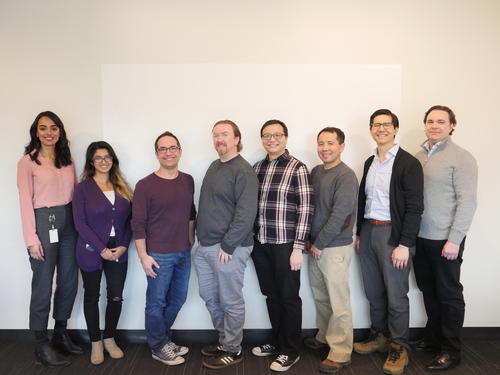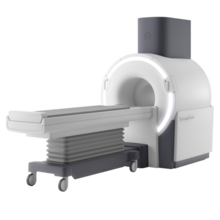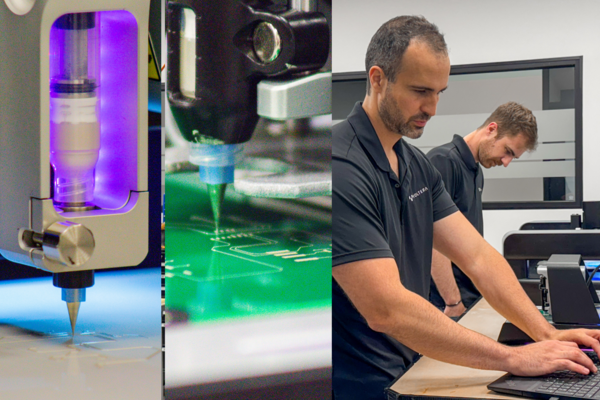
Synaptive Medical increases access to MRI
Company led by Waterloo alumni creates a new system to improve urgent care.

Company led by Waterloo alumni creates a new system to improve urgent care.
By Claire Mastrangelo Office of AdvancementSynaptive Medical’s office is buzzing on a bright afternoon in February. Health Canada just approved the company’s latest product, Evry™, an MRI system for emergency rooms. Co-founder and president Cam Piron (BASc ’98) has just arrived on a redeye flight from Calgary, and he’s on his way to the office to give interviews and begin next steps with his team.
“We have one system installed in Nova Scotia, and a few sites ready to go in Toronto,” he says. “It’s going to be very exciting for us to see physicians use Evry to treat patients.”

Cam Piron (BASc ’98, far right) poses for a photo with some of the Waterloo alumni making an impact at Synaptive Medical.
Creative problem solving
 Synaptive created Evry to solve a problem of accessibility. MRI systems, which scan patients to produce detailed images of the inside of the body, require huge amounts of space and technical skill to operate. They’re also expensive. That means not all hospitals can afford them, making access difficult when patients need urgent care.
Synaptive created Evry to solve a problem of accessibility. MRI systems, which scan patients to produce detailed images of the inside of the body, require huge amounts of space and technical skill to operate. They’re also expensive. That means not all hospitals can afford them, making access difficult when patients need urgent care.
So, Cam and his team wanted to create a smaller machine that could improve patient assessment — and ultimately, treatment — in critical situations like a stroke or trauma to the head.
“If you can put an MRI in an emergency room, you can move people through more confidently,” says Cam. But to get the systems where they were needed, Synaptive had to make them smaller, less costly and easier to use.
Finding their focus
By imaging only the brain, Synaptive was able to create an MRI system that took up just 250 square feet instead of the thousands that standard systems require. The team built a simpler interface that allowed practitioners to use the system with less technical knowledge. They also found ways to run the system more efficiently, which lowered operating costs.
“Everyone’s excited to see this MRI come forward,” says Cam. “We consulted widely with clinicians, so the voice of the customer really is built into the system.”
Cam Piron (BASc ’98), Josh Richmond (BASc ’98) and Thanh Vuong (BASc ’98, MASc ’02) talk about their experience at Waterloo, and how it prepared them to lead the team at Synaptive Medical.
A system built for Canada
As Cam explains, Evry has a different origin from other MRI technology.
“Manufacturers have been addressing a separate problem from us: how to produce better imaging. Unfortunately, when you do that, the systems get bigger and more expensive. By looking at a different problem, we created different technology. Now, we can get images that are comparable to our competitors’, but we can do it more easily and, we hope, with better outcomes for the patient.”
As health care practitioners start using the systems, Cam and his team will continue to consult with them to ensure their system provides the greatest possible benefit to patients.
“As a Canadian health tech company, we can address problems that are amplified in Canada, like hallway medicine and backups in emergency rooms,” says Cam. “These are areas where I think we can have a significant impact.”

Read more
Here are the people and events behind some of this year’s most compelling Waterloo stories

Read more
For more than four decades, Waterloo professor Larry Smith has helped build the University's reputation for innovation and entrepreneurial excellence

Read more
Voltera prints electronics making prototyping faster and more affordable — accelerating research to market-ready solutions
The University of Waterloo acknowledges that much of our work takes place on the traditional territory of the Neutral, Anishinaabeg, and Haudenosaunee peoples. Our main campus is situated on the Haldimand Tract, the land granted to the Six Nations that includes six miles on each side of the Grand River. Our active work toward reconciliation takes place across our campuses through research, learning, teaching, and community building, and is co-ordinated within the Office of Indigenous Relations.